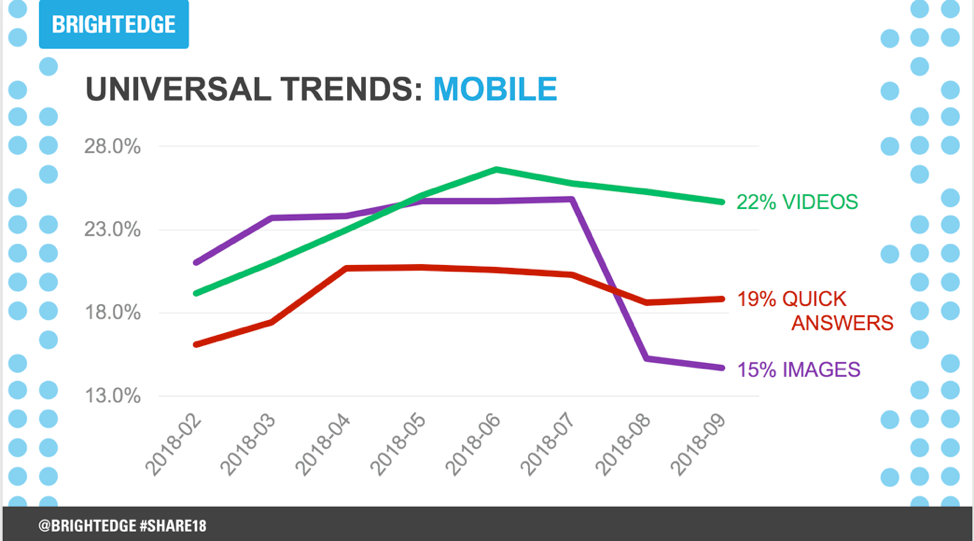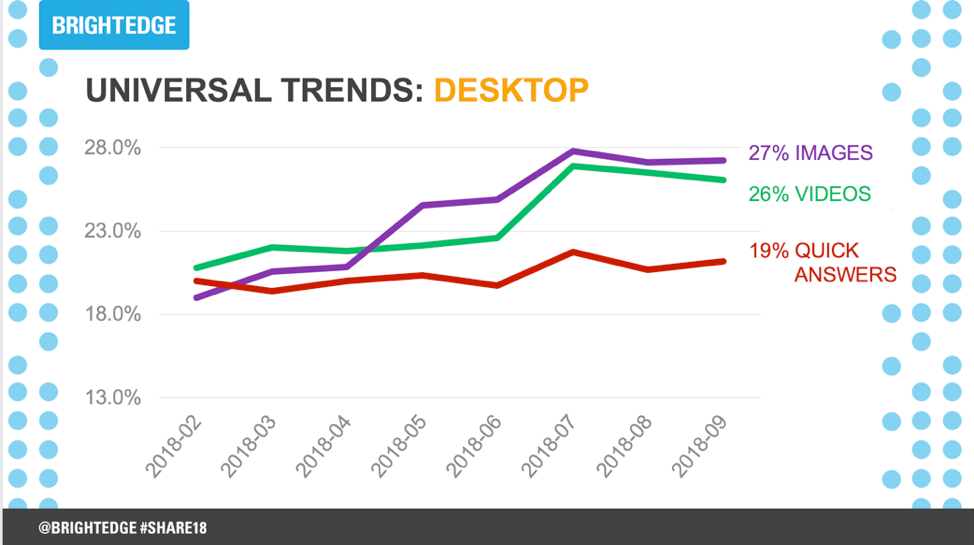Video content impacts organic performance more than any other asset that can be displayed on a web page. In today’s online marketing world, videos have become an integral step in the user journey.
Yet for the large enterprises, video optimization is still not an essential part of their website optimization plan. Video content is still battling for recognition among the B2B marketer. Other industries, on the other hand, have already harnessed this power of video.
In the recent Google Marketing Live, Google mentioned that 80% of all online searches are followed by a video search. Some other stats to take into consideration, according to Smallbiztrends by 2019, global consumer Internet video traffic will account for 80% of all consumer Internet traffic. Furthermore, pages with videos are 53 times more likely to rank on Google’s first page.
I took a deeper look into video content and its impact on organic performance. My analysis started in the fall of 2018. Google had already started to display video thumbnails in the SERPs. According to research from BrightEdge, Google is now showing video thumbnails in 26% of search results.


Source: BrightEdge
Understanding the true influence of video SEO for your business will require some testing. I did four different sets of tests to arrive at the sweet spot for our pages.
The first test was to gauge if having video content on the page made any significant changes. I identified a page that ranked on page four of the SERP’s in spite of being well optimized. The team placed video content relevant to the textual content to the page. And the test result was loud and clear, having a video on the page increased relevance, resulting in increased rankings, and visibility in universal search. The Page started to rank on page one and the video thumbnail in the SERPs displayed the desired video and linked back to the page.
The next test was to understand the impact of the method of delivery. I measured what was the level of user engagement and organic performance when video contents are displayed/delivered on the page via different formats. The page was set up wherein users could get access to the video content either via a link that would take the user to YouTube or as a pop-up or as an embedded file that actually plays the video on the page itself. Results were very evident – every time the video was embedded on the page the user engagement increased, which decreased the bounce rate, and improved page ranking.
Taking a step further in our testing journey, I conducted a follow-up test to evaluate which category of video content performs better? Like any other SEO strategy, video optimization isn’t different. Skip the marketing fluff and go for product feature videos, “how-to” videos, or “what is” videos. We tested assorted video contents on the same page. Whenever the content of the video addressed a user need and was relevant to the page textual content the page rankings improved.
Lastly, I tested if Google prefers YouTube videos or domain hosted videos. On this subject, several of my business colleagues and I have budded heads. There is no universal truth. Google does display both YouTube and domain hosted videos in the thumbnails on the SERPs. Different sites will see different results. I tested the impacts of an embedded YouTube video on the page. What I found was something I had not even considered in my hypothesis. When the video was already present on YouTube and then embedded on the page, the URL improved in rankings and at the same time the thumbnails on the SERPs showed the YouTube video but when the user clicked on the video it took them to the product page and not to the YouTube video.
Key takeaway
Many enterprise SEO strategists failed to leverage the video content because they feel their products are not that B2C in nature. Remember that search engines like videos because searchers like videos.
Videos take the static image or textual content to experience content, wherein the user can actually view how to use the information. This brings in a much higher and stronger level of engagement that in turn improving the brand reputation.
What video content should you consider?
I recommend starting at square one – what is the user intend/need you are trying to address. Define the goals you want to achieve from this video marketing. Are you looking to drive conversions or spread brand awareness? Put some thought into whether the video is informative and engaging and whether it is relevant to the page that it is displayed in.
Don’t overlook how that message is conveyed as well. Take into account personas as that establishes your intended target audience, the overall tone that the video should take. What stage of the user journey is being targeted? Understanding the areas where video results are high can help provide insight and guidance for additional content strategy ideas.
Things to remember when starting to incorporate video content
More and more people are searching and viewing content on their handheld devices. Therefore, you have to optimize this content with a mobile-first approach.
The basic SEO principle still applies. Optimize title, description, tags, transcript. Matching these to the user intent can encourage click-throughs
- Ensure its page placement. Always surround your video with relevant content to tie it all together.
- Videos up to two minutes long get the most engagement. Keep them short and let your brand shine through.
Don’t just link to it, embed it onto your site and make sure the video image is compelling.
This is the critical time to incorporate video content and optimization into your content strategy for 2019. When quality videos are added to web pages, it gets recognized as rich content, a step up from the regular text-filled pages. Video content will only help your optimization strategy in expanding your reach to driving engaged site visits.
Tanu Javeri is Senior Global SEO Strategist at IBM.
The post Don’t underestimate the power of video appeared first on Search Engine Watch.
from SEO – Search Engine Watch https://ift.tt/2JQpLzN
via IFTTT

No comments:
Post a Comment